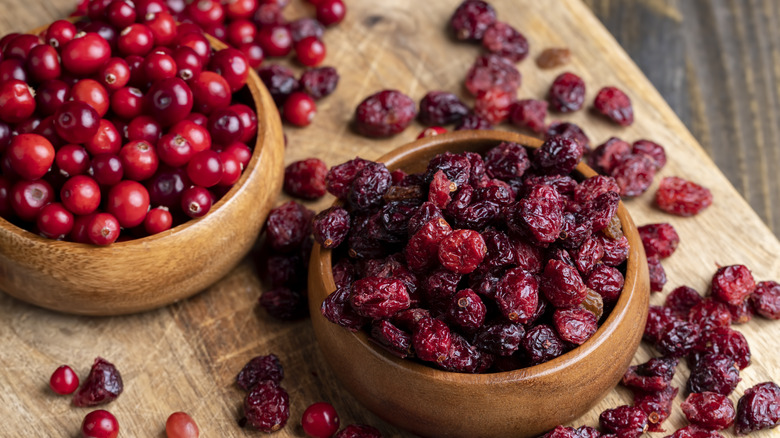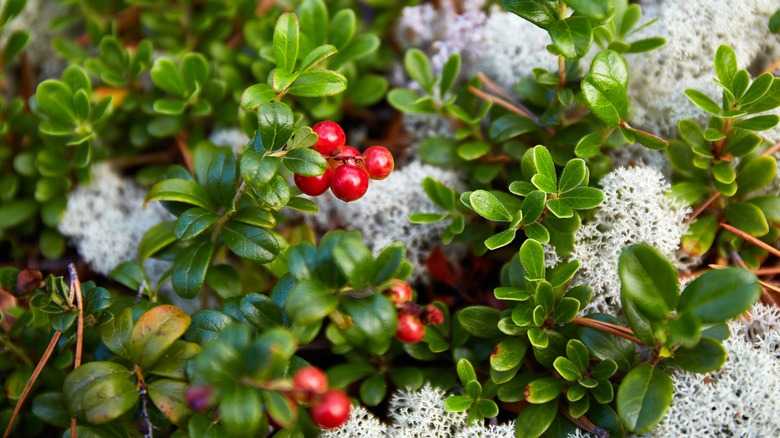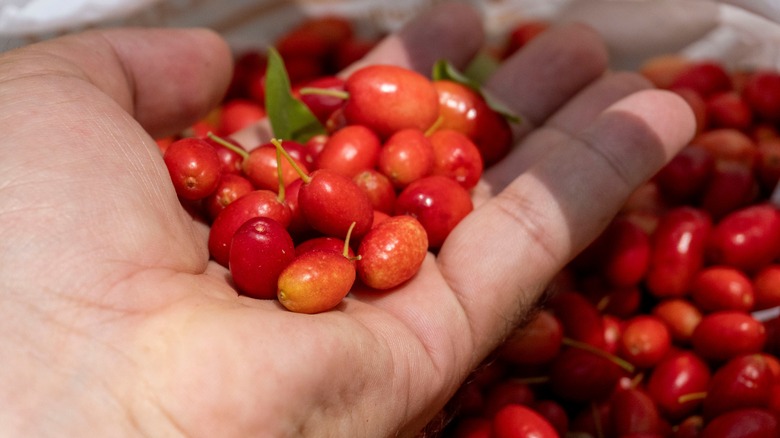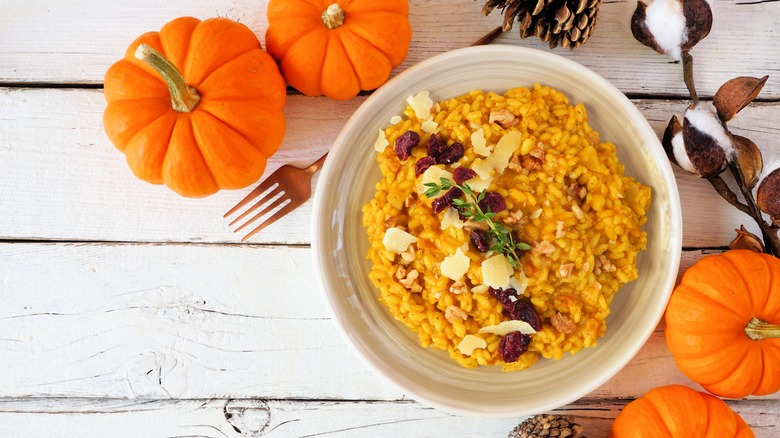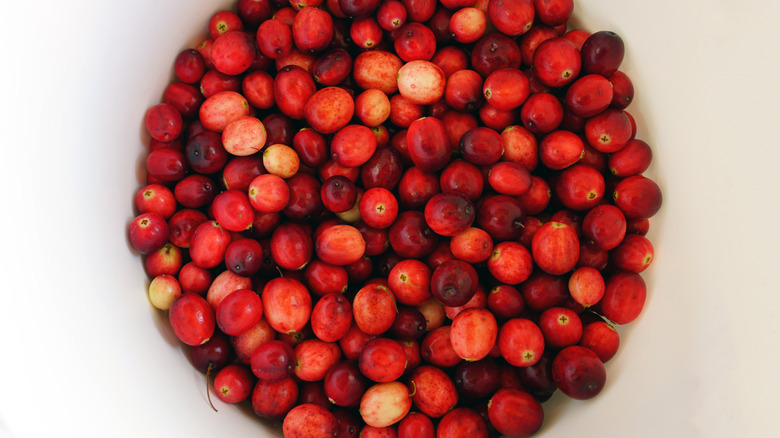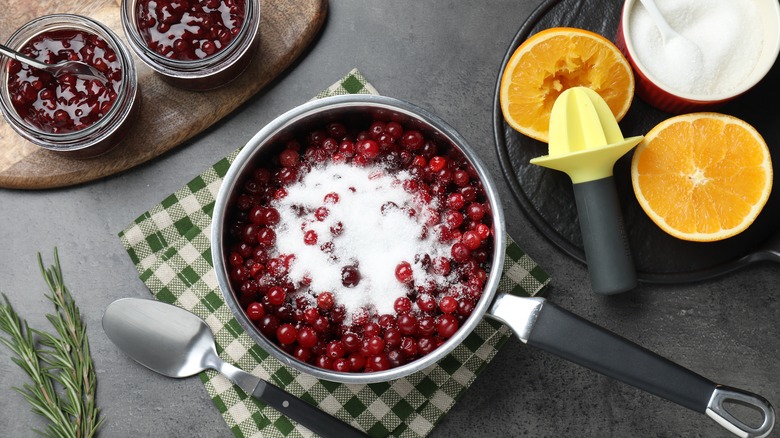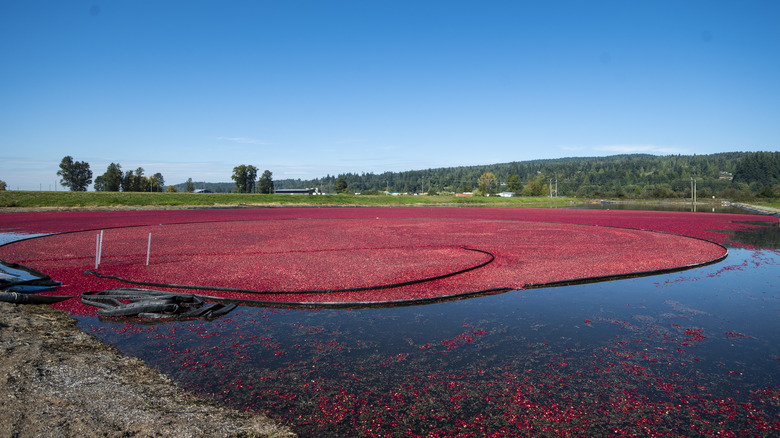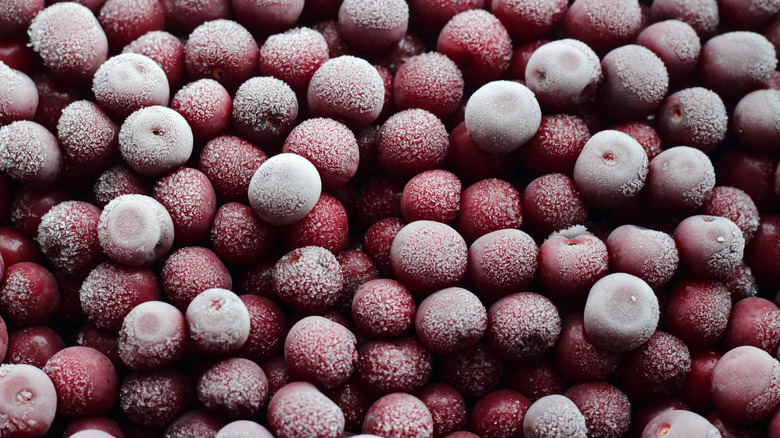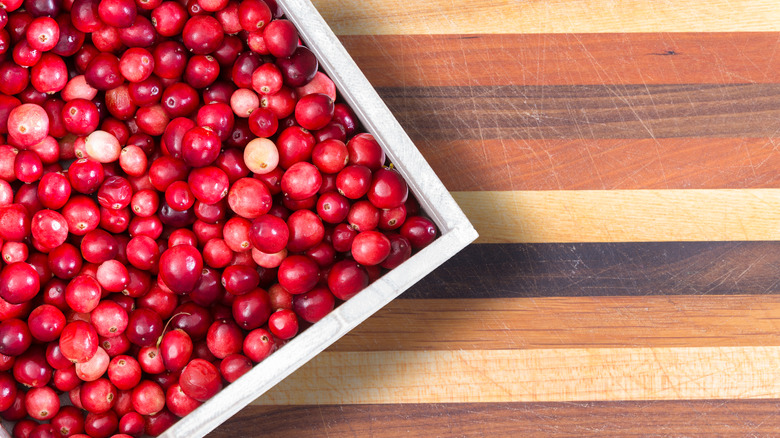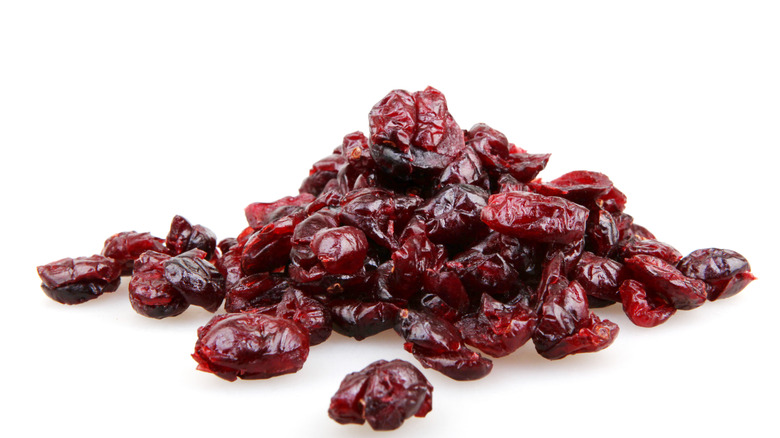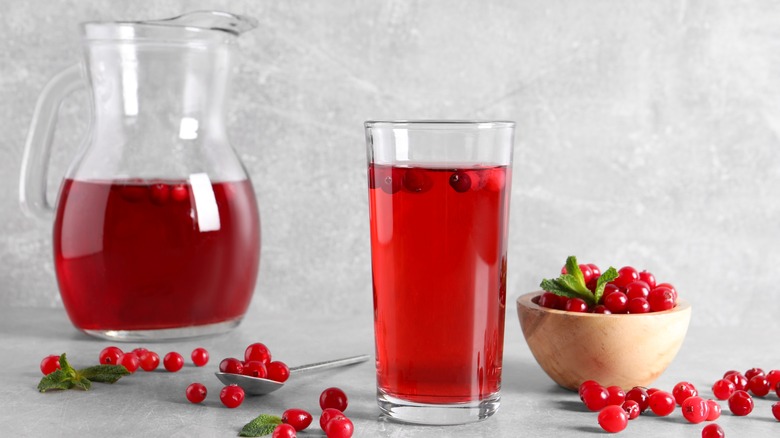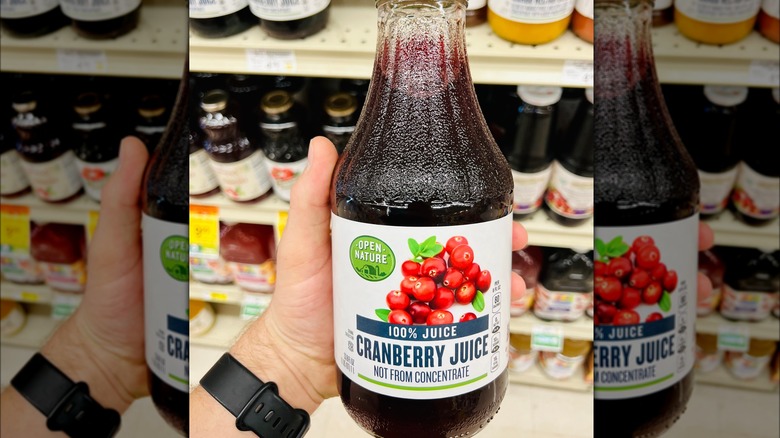False Facts About Cranberries You Thought Were True
Cranberries might conjure up images of Thanksgiving feasts or bright glasses of juice, but despite their popularity, it's surprising how little many people know about them. This isn't helped by common myths and misconceptions about cranberries floating around. From the notion that they grow in water to the idea that they can cure urinary tract infections, there are a lot of common beliefs about these little fruits. But, how many of them are true?
As a seasoned food writers and recipe developers, we know our way around a cranberry, but we wanted to talk to experts in the field. We spoke to a trained chef and culinary instructor, plus two food bloggers who have extensive experience working with cranberries. Based on the information they gave, We've managed to get to the bottom of common misinformation. Here, you'll find 11 false facts about cranberries you thought were true, along with the reality behind them. No more being left in the dark about these berries, it's time to get real. Next time you cook with them, you'll be able to sort the fact from the fiction, which might help you make the most out of them.
False: Cranberries grow in water
If you want to learn everything there is to know about cranberries, you're probably curious about how they're grown. Many people think that cranberries grow in water, but this isn't true. The myth likely comes from that Ocean Spray packaging featuring cranberries bobbing around in water, but that's a bit of artistic license. Really, they grow on bushes — and on dry land.
"Cranberries are not grown in water, but water is used during harvest to help gather the fruit more easily," notes Ann Ziata, chef at the Institute of Culinary Education's New York City campus. "They don't actually grow under the water, but the fields are often flooded during harvest to make the fruit float for easier harvesting," says Lindsey Chastain, a homesteader and food blogger at The Waddle and Cluck.
So, no, cranberries aren't grown in water, but water is involved in the harvesting process. These berries contain pockets of air that make them float to the surface of water. So, some commercial producers flood the fields where cranberries are growing and use a special device to cut them from their vines. At this point, they're free-floating on the surface of the water, so they need to be rounded up. Then they're removed from the water using suction. It might seem like a fairly complicated way to harvest fruit, but it's certainly easier and less labor-intensive than picking by hand.
False: You can't eat raw cranberries
Do you think that you can't eat cranberries raw? Some people think they're unsafe to eat raw or will give you an upset stomach. However, the fact is, you absolutely can eat them raw. There's a catch, though: you might not want to.
"Raw cranberries are safe to eat, but are not very enjoyable," Institute of Culinary Education chef Ann Ziata tells us. "Cranberries are extremely bitter and are best prepared cooked or dried with a little sweetener." Yumna Jawad, cookbook author and recipe developer at Feel Good Foodie agrees that they're not the most enjoyable to eat raw. "When I've tried them they can just be quite tart with a strong bitter taste," she says.
So, as with many things in life, just because you can do it, it doesn't mean you should. It's technically safe to eat raw cranberries, but it's not like eating a strawberry or blueberry. These berries are best cooked — and preferably sweetened. Plus, although they aren't dangerous to consume uncooked, you might not like how it makes you feel if you eat too many. "While not commonly done, consuming large quantities of raw cranberries may irritate the stomach," warns Ziata. Sure, give a raw cranberry a nibble if you're curious, but don't chow down on a huge bowl of them.
False: There are limited things you can make with cranberries
If you think that cranberries begin and end with Thanksgiving cranberry sauce, you're in for a surprise. There are so many excellent cranberry recipes that are great for the holidays and beyond. Those who don't cook with cranberries are missing out on an incredible ingredient that can bring a lot to a range of dishes.
"I love using them in baked recipes that can balance their tartness with something sweet," says recipe developer Yumna Jawad. She mentions orange and cranberry bread, cranberry-almond granola, and cranberry-pecan baked oatmeal as some of her favorites. "Fresh cranberry scones and muffins are always a hit," says Chef Ann Ziata. And cranberry pie is a holiday staple in many households.
But cranberries go way beyond sweet recipes and work beautifully in savory dishes, too. While she's a fan of cranberry sauce, recipe developer Lindsey Chastain says, "I have also created a cranberry and cheese stuffed chicken that turned out great." She adds that "mixing wild rice, dried cranberries, celery, onion, carrots, almonds and cooking in a chicken broth makes a great rice pilaf side dish."
Ziata also has some great savory ideas for cranberries. "Cranberries go great with whole grains, caramelized proteins, and creamy cheeses," she notes. "Fry up cranberry and bulgur croquettes and serve with a little herb aioli," she suggests. She also likes to stuff winter squash with cranberries, farro, and sage or make a cranberry-white cheddar grilled cheese.
False: All cranberries are red
The cranberries you see in stores are red, as is the cranberry juice you drink, and the canned cranberry sauce on your Thanksgiving table. So, it seems to follow that all cranberries are red. However, this isn't the case. Some cranberries are white.
"White cranberries are ripe cranberries picked early in the season, before the red color develops," explains Ann Ziata of the Institute of Culinary Education. "Other than the color, white cranberries are similar in flavor and texture to red cranberries. If you can find them, use them! They are delicious and the freshest you can find."
That's a resounding seal of approval for white cranberries. And there's also something interesting about them. "Fun fact: if you freeze white cranberries they turn red," homesteader Lindsey Chastain tells us. Cooking turns them red, too, and "they also will continue to darken as they age," according to Chastain.
The reason for their white color is the lack of the red pigment anthocyanin. It hasn't yet had the time to develop in white cranberries, but freezing, cooking, or just time brings it out. You can also find some pinkish cranberries, which are part way between the white stage and the red stage. If a cranberry is white, pink, or red, it's ripe and ready to eat. But if it's green, it's underripe and no good.
False: You need a lot of sugar to make cranberries taste good
Cranberries are naturally tart, so you might assume you need lots of sugar to make them taste good, but this isn't necessarily true. Sure, some recipes that use cranberries need a fair amount of sweetness, especially if the berries are the main ingredient. For other recipes, you can go surprisingly light on the sugar.
"You don't need a ton of sugar to make them taste good, a little goes a long way," Chef Ann Ziata tells us. There are some amazing ways to use cranberries, and if you're following a recipe, just stick to the amount of sugar called for. However, when you're experimenting with your own recipes, or just making it up as you go, things get a bit more complicated. Start with less than you think you might need, taste as you go along, and add more as needed.
"Don't just use white sugar, either," Ziata says. "Honey, maple syrup, and orange juice all work great." Whatever sweetener you use, you'll need more in sweet recipes than in savory ones. If you're cooking cranberries in savory dishes, you might just need a teaspoon or two of sugar to balance out the tartness.
False: Growing cranberries wastes a lot of water
Despite common misconceptions, cranberry farming actually doesn't waste a lot of water. Yes, cranberries do require plentiful water to thrive, but growers have procedures to manage and conserve water effectively. Flooding is used mainly during the harvest season, when fields are flooded to make gathering the fruit easier. However, cranberry growers often recycle water. After flooding the fields for harvest, the water is typically pumped out and stored in reservoirs or reused for irrigation. This minimizes water waste and helps maintain a sustainable water supply.
During the growing season, cranberry fields are irrigated, but this water use is carefully controlled. Efficient irrigation systems make sure water isn't wasted. For instance, farmers might use drip irrigation or sprinkler systems to give the plants the perfect amount of water without waste. With these systems, water is delivered directly to the roots, so there's less evaporation and runoff.
What's more, growers often create reservoirs and ponds to capture and store rainwater and excess water from flooding. This stored water can then be reused for irrigation, reducing the need to draw from natural water sources. And since cranberries need a good supply of clean water for growing, farmers are invested in keeping local watercourses free from contamination. Sure, it takes a large amount of water to grow cranberries, but water isn't wasted.
False: Fresh cranberries are always better
Fresh foods are often seen as the superior choice without exception. So, you might believe that you should always opt for fresh cranberries, never frozen. There are some instances when frozen cranberries can be superior, or at least just as good, such as when the berries are out of season.
"Cranberries freeze very well and can easily be substituted for fresh in most recipes," says Ann Ziata. "If you are cooking the berries, you do not need to thaw them first," she adds. Cookbook author and recipe developer Yumna Jawad tells us she's a fan of frozen versions. "I like to add frozen cranberries into my morning oatmeal while it cooks or drop them (still frozen) into a bubbly fruit seltzer drink at the end of the day," she says.
"The main benefit to using frozen is that you can use cranberries out of season," food blogger Lindsey Chastain remarks. She adds that frozen ones are often less expensive than fresh. You can also use frozen cranberries to make cranberry sauce. Because they get broken down in the sauce, it doesn't matter if the texture is a little off from freezing — it should still turn out the same way. And if you make too much, there are some great ways to use up leftover cranberry sauce.
False: You can't use cranberries once they've turned soft
Cranberries are known for being so firm you can bounce them. It follows, then, that you might assume you have to throw them out as soon as they go a little soft. But they might have some life left in them. Cranberries take longer to go bad than you might imagine. They can last for up to six weeks in the fridge or 12 months in the freezer.
Yumna Jawad of Feel Good Foodie says that softness means cranberries are overripe or perhaps just starting to spoil, but they're likely still okay to use. "As long as they don't have any mold or a weird smell, I recommend using them in cooking or baking where their texture will be less noticeable, like in sauces, jams, or baked goods," she says. Lindsey Chastain of The Waddle and Cluck agrees. "You can still use soft cranberries for cooking, just make sure that they are only soft and have not gone bad," she remarks. "The flavor will be the same."
But not everyone thinks soft cranberries are alright to use. "Discard any cranberries that have turned soft," says Ann Ziata of the Institute of Culinary Education. "They should be firm and crisp." If you intend to use soft cranberries, use your judgment — and your senses — to make sure they're just on the far side of ripe and haven't spoiled.
False: Cranberries are high in sugar
Cranberry juice and cranberry sauce are both quite sugary. This might be why people assume that cranberries themselves are high in sugar. However, these kinds of products have added sugar. The berries themselves aren't to blame. "One common myth I hear a lot as a diabetic is that cranberries are high in sugar or fructose," says recipe developer Lindsey Chastain. "Fresh cranberries are actually low on the glycemic index and dried cranberries are in the mid range because they usually have added sugar. Cranberry juice is very high in sugar as are most juices."
So, depending on the type of cranberry product you're eating, it might not be particularly high in sugar. It makes sense when you think about it because cranberries are quite tart. Sweeter berries — like raspberries and strawberries — along with most other fruits do contain a lot of a sugar called fructose. It's not inherently unhealthy unless you have a condition like diabetes that requires you to restrict your sugar intake. Cranberries don't contain a particularly large amount of fructose and therefore are unlikely to cause a blood sugar spike in their natural form. Of course, we all know that cranberries are rarely eaten raw, so if you're watching your sugar intake, check how much added sugar is in a recipe or a cranberry product.
False: You can cure a urinary tract infection with cranberry juice
You've probably heard that cranberry juice can help clear up a urinary tract infection (UTI), but it isn't as simple as that. While there's some degree of truth behind the myth, you should think twice before drinking cranberry juice to treat a UTI. This juice contains some compounds that might help avoid UTIs in the first place, but it won't be able to rid you of one that's already established.
Here's the fact behind the fiction: cranberries contain compounds such as proanthocyanidins, flavonoids, and phenolic acids. These are able to reduce the amount of bacteria that hangs around the urinary tract, therefore reducing the chance of getting a UTI. It's not necessary for most people to take preventative measures, but people who get recurring infections might want all the help they can get. And why cranberry juice? Probably because it's easy to get hold of and more pleasant to consume in large volumes compared to, say, raw cranberries or a can or cranberry sauce. You can also buy cranberry pills that contain these compounds in a more concentrated form.
So, cranberries might be able to prevent UTIs, but what about when you already have one? Well, unfortunately, they're not going to cut it. Although some mild infections go away on their own, it's best to see a doctor when you have one. They can determine whether or not you need a course of antibiotics to clear it up.
False: The label 100% juice on cranberry juice means it's all cranberries
While cranberry juice tastes great, it can contain a lot of sugar. So, if you spot a bottle that's labeled "100% juice" or "100% juice cranberry," you might assume it's all cranberry juice. Great — you can enjoy cranberry juice in its pure, unadulterated form. But, wait — there's actually something else going on here. These bottles are all juice, but they're not all cranberry juice.
The thing is, cranberry juice with nothing else added would be extremely tart, so it's probably not what you want. Cranberry juice labeled 100% juice contains a blend of cranberry juice and other, sweeter juices, such as apple juice or grape juice. While the flavors of these juices come through somewhat, it's still a good way to get that cranberry juice flavor without added sugars or sweeteners. The alternative is a cranberry juice cocktail, which contains cranberry juice, water, and sugar, high-fructose corn syrup, or artificial sweeteners.
